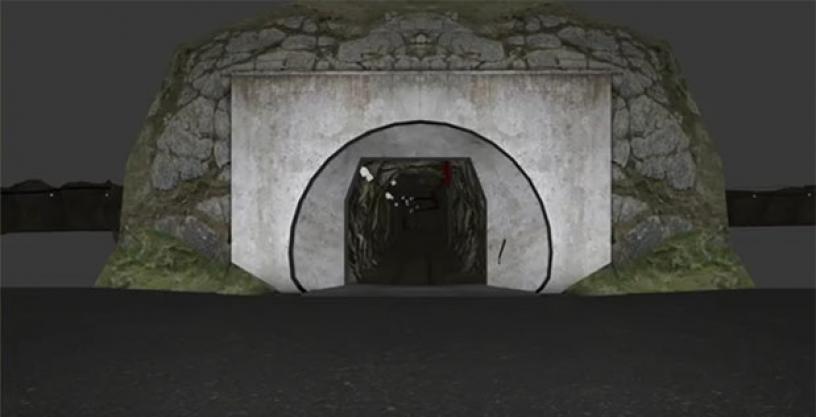
Virtual Competition is active through August 1, 2019; registration open for Tunnel Circuit media day
Jul 2, 2019
The DARPA Subterranean (SubT) Challenge opened the Virtual Tunnel Circuit competition July 1 with nine teams vying for a top finish in the event and $500,000 in prizes. Teams that have already qualified can submit their virtual entries at the SubT Virtual Portal during the submission window, which remains open through August 1, 2019. Selecting from a repository of robot models and a variety of sensors, each team can assemble a fantasy sports-style solution to map, navigate, and search the dark, dangerous, and unpredictable underground scenarios.
The Subterranean Challenge seeks to better equip warfighters and first responders to explore human-made tunnel systems, urban underground, and natural cave networks, while decreasing risk to human lives. The SubT Challenge physical Systems and software-focused Virtual competitions aim to create a community of multidisciplinary teams from disparate fields to foster breakthrough technologies in autonomy, perception, networking, and mobility for underground environments.
Virtual Teams
The following organizations have qualified and intend to compete in the Virtual Tunnel competition. Additional teams may submit materials to qualify for future events including the Urban Circuit, Cave Circuit, and Final Event.
- AAUNO, Australia
- BARCS: Bayesian Adaptive Robot Control System (DARPA-funded)
o Michigan Technological University/Michigan Tech Research Institute, Ann Arbor, Michigan - COLLEMBOLLA: Communication Optimized, Low Latency Exploration, Map-Building and Object Localization Autonomy (DARPA-funded)
o Scientific Systems Company, Inc., Woburn, Massachusetts - Coordinated Robotics, Newbury Park, California
- CYNET.ai, Middletown, New Jersey
- Flying Fitches, Germany
- Metastable Labs, Austin, Texas
- Robotika
o Robotika International, Czech Republic and United States
o Robotika.cz, Czech Republic
o Czech University of Life Science, Czech Republic
o Centre for Field Robotics, Czech Republic
o Cogito Team, Switzerland - SODIUM-24 Robotics, Dallas, Texas
Virtual Competition – How it Works
To begin, each team assembles a roster of robots and sensors by selecting from the available configurations on the SubT Tech Repo. Each robot configuration has an associated cost, measured in SubT Credits – an in-simulation currency – based on performance characteristics such as speed, mobility, sensing, and battery life. The team rosters are limited to a maximum combined cost of 1,000 SubT Credits.
Next, each team writes software and algorithms for their set of robots to compete in the simulated environments. Just as in the real-world competition courses, Virtual competitors will explore the tunnel environment and attempt to identify artifacts within a five-meter radius accuracy during a 60-minute timed run. A correct report is worth one point. Each course contains 20 artifacts, which means each team has the potential for a maximum score of 20 points.
Complete rules for the Virtual Tunnel competition are available under the resources tab on the Subterranean Challenge website.
During the submission window, teams will have access to several practice scenarios to repeatedly test and perfect their approach before they submit one official solution for scoring. The DARPA team will then evaluate the solution on a set of hidden competition scenarios.
DARPA will announce final results of the Virtual Tunnel Circuit alongside the Systems Tunnel Circuit results on August 22. The Systems Tunnel Circuit will take place August 15-22 in Pittsburgh at the National Institute for Occupational Safety and Health (NIOSH) Mining Program's Safety Research Coal Mine and Experimental Mine. Self-funded Virtual teams may compete for one of three top prizes, provided they finish in the top five overall ranking: $250,000; $150,000; or $100,000, respectively. DARPA-funded teams in the Systems and Virtual competitions are only eligible for prizes in the Final Events.
Reporters are invited to attend a Tunnel Circuit media day Tuesday, August 20. The registration deadline for U.S. citizens is Wednesday, July 31. The deadline has passed for non-U.S. citizens to attend this event. Please visit the media registration site for details.
Please email questions to SubTChallenge@darpa.mil.
Image Caption: Still of a virtual fly-through of the Edgar Experimental Mine, where Systems teams participated in the SubT Integration Exercise in April 2019. Image credit: Open Robotics
# # #
Media with inquiries should contact DARPA Public Affairs at outreach@darpa.mil
Associated images posted on www.darpa.mil and video posted at www.youtube.com/darpatv may be reused according to the terms of the DARPA User Agreement, available here: http://go.usa.gov/cuTXR.
Tweet @darpa
